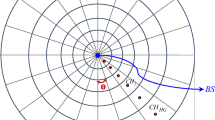Abstract
Wireless network sensing and control systems are becoming increasingly important in many application domains due to advent of nanotechnology. The size of a wireless sensor network can easily reach hundreds or even thousands of sensor nodes. Since these types of networks usually have limited battery resources, power consumption optimization for prolonging system lifetime of such networks have received a great attention by the researchers in this field in recent years. In this paper, a centralized approach for clustering and data transmission mechanism is proposed that optimizes the power consumption and hence lifetime of the network. The mechanism is comprised of two phases. In the first phase, a mechanism based on a centralized cluster head selection that utilizes information such as nodes residual energies and their locations in the network is proposed in order to select the most appropriate candidates as cluster heads. In the second phase, the concept of a “window size” is introduced where minimization of the number of cluster head changes of a node and consequently maximization of the network lifetime is considered. Simulation results validate that the proposed mechanism does effectively reduce data traffic and therefore increases network lifetime.







Similar content being viewed by others
References
Doherty, L., Warneke, B. A., Boser, B. E., & Pister, K. S. J. (2001). Energy and performance considerations for smart dust. International Journal of Parallel and Distributed System and Network, 4(3), 121–133.
Heinzelman, W. B., Chandrakasan, A. P., & Balakrishnan, H. (2002). An application-specific protocol architecture for wireless microsensor networks. IEEE Transaction on Wireless Communication, 1(4), 660–670.
Tong, M., & Tang, M. (2010). LEACH-B: An improved LEACH protocol for wireless sensor network, 6th International Conference on Wireless Communication Networking and Mobile Computing (WiCOM).
Heinzelman, W. (June 2000). Application-Specific Protocol Architecture for Wireless Networks, Ph.D Thesis, Massachusetts Institute of Technology.
Hong, J., Kook, J., Lee, S., Kwon, D., & Yi, S. (2009). T-LEACH: The method of threshold-based cluster head replacement for wireless sensor networks. Information Systems Frontiers, 11(5), 513–521.
Lindsey, S., & Raghavendra, C. (2002). PEGASIS: Power-efficient gathering in sensor information system. IEEE Aerospace Conference Proceeding, 3, 1125–1130.
Singh, S. K., Singh, M. P., & Singh, D. K. (2010). Routing protocols in wireless sensor networks—A survey. International Journal of Computer Science & Engineering Survey (IJCSES), 1(2). doi:10.5121/ijcses.2010.1206.
Yu, Z., Fu, X., Cai, Y., & Vuran, M. C. (2011). A reliable energy-efficient multi-level routing algorithm for wireless sensor networks using Fuzzy Petri Nets. Sensors, 11(3), 3381–3400.
Min, X., Wei-ren, S., Chang-jiang, J., & Ying, Z. (January 2009). Energy efficient clustering algorithm for maximizing lifetime of wireless sensor networks. AEU International Journal of Electronics and Communication, 64(4), 289–298.
Muruganthan, S. D., Ma, D. C. F., Bhasin, R. I., & Fapojuwo, A. O. (2005). A centralized energy-efficient routing protocol for wireless sensor networks. IEEE Radio Communication, 43, S8–S13.
Kumar, V., Jain, S., & Tiwari, S. (September 2011). Energy efficient clustering algorithms in wireless sensor networks: A survey. International Journal of Computer Science Issues (IJCSI), 8(5).
Fasolo, E., & Rossi, M. (2007). In-network aggregation techniqes for wireless sensor networks: A survey. IEEE Wireless Communication, 14(2), 17–87.
Galluccio, L., Palazzo, S., & Campbell, A. T. (2009). Modeling and designing efficient data aggregation in wireless sensor networks under entropy and energy bounds. International Journal of Wireless Information Networks, 16(3), 175–183.
Heinzelman, W. B., Chandrakasan, A. P., Balakrishnan, H. (2000). Energy-efficient communication protocol for wireless microsensor networks. In Proceedings of the 33rd Hawaii international conference on system sciences. doi:10.1109/HICSS.2000.926982.
Author information
Authors and Affiliations
Corresponding author
Rights and permissions
About this article
Cite this article
Ghaffarzadeh, H., Doustmohammadi, A. Two-phase data traffic optimization of wireless sensor networks for prolonging network lifetime. Wireless Netw 20, 671–679 (2014). https://doi.org/10.1007/s11276-013-0629-2
Published:
Issue Date:
DOI: https://doi.org/10.1007/s11276-013-0629-2




